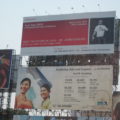Most of the people I’ve filmed so far for Sun don’t have extensive television or other on-camera experience and, needless to say, are not professional actors. Being comfortable in front of a camera is a good skill to have in our video-driven age, but it doesn’t come naturally to most. The tips below are some things I’ve learned in my attempts to put my subjects at ease.
Those of you who’ve had the pleasure (?) of being in front of my camera will have heard a lot of this already. If you have more to add, I’d love to hear it (in the comments).
Preparation:
How much you prepare in advance is, as far as I’m concerned, entirely up to you. Often the preparation is already done, because we’re capturing on film a presentation, TOI, etc. that you have already delivered one or more times. But I’ve also filmed off-the-cuff interviews where the interviewer and interviewee met for about ten minutes beforehand, agreed on a list of questions, and then sat down in front of the camera and talked. When both parties know their topic (and you do), this works just fine.
If you say something you wish you hadn’t, or stumble over a line, we can always edit it afterward, or do another take. You don’t have to be perfect the first time, or even the second.
There is no canonical length for online video. As long as what you have to say is interesting and useful to your audience, they will watch it. Probably not in YouTube viral numbers, but the people who matter (even if they’re only a handful) do pay attention.
Humor is great if it comes naturally to you, but there’s no need for gimmicks to keep your audience engaged.
Clothing:
- Do NOT wear narrow vertical stripes. They cause moiré patterns which look psychedelic on video – probably not the effect you’re looking for.
- Warmer colors are preferable to black or gray, which can look very funereal on camera.
Standing, Moving:
- Don’t feel that you have to stand in one place for the camera. If you naturally tend to pace when speaking, go ahead and do that – you’ll feel more comfortable, and that makes better video (I’ll follow you with the camera – it’s my job to keep you in the frame).
- Hand gestures are great (they add liveliness), but try to keep them high on the body (waist level or above) so I can catch them while still zoomed in to get a good view of your face.
Where to Direct Your Gaze:
To get the most natural result for the video viewers, it’s best if you look directly into the camera lens, as if it was the face of the person you’re talking to. However, this can be hard to do without a lot of practice, and some people are uncomfortable with it.
- If there are two or more of you: In interviews or round-table sessions, you’ll probably find it natural to look at each other more than/instead of the camera. But do try to include the camera in the conversation, as if it was another person – this makes your future viewers feel included.
- If it’s just me filming you, I try to position myself so that, if you talk to me, you’re also making “eye” contact with the camera lens.
- If I can film you in front of a real audience, that often works better: many speakers find they are more energetic when they’ve got the right people listening to them.
Scripts and Prompts:
- I have rarely filmed anything totally scripted (though you can certainly do that if you prefer), but you may find it helpful to speak from notes or slides.
- You can improvise a “teleprompter” by printing your notes or script large enough to be read from a distance (e.g., from the floor while you’re sitting in a chair). I’ve even had someone stand beside the camera and “wind” a scrolling script for my subject to read – the result was great because the position of the script kept her looking towards the camera the whole time. Another time, the subject wrote (in advance) on a flipchart that she positioned near my shoulder so she could look into the camera while following her notes.
Slides:
When I film a presentation with slides, I usually zoom in on the speaker’s face/upper body, and may not get the slides into the frame at all (unless you’re walking in front of the screen gesturing at a slide – that’s okay, too). I take notes on the timing of slide flips (using the timecode on the videotape as I’m filming) and later edit in the slides as graphic overlays; here’s an example.
Many speakers make slides so dense with information and small text that they cannot be read at video resolution (nor from the back of a room). Needless to say, this makes things hard for your viewers.
- If you’ve got so much text on your slide that the font becomes too small too read, you probably need to use less text and/or break that thought into two or more slides.
- Some complex diagrams simply can’t be broken down. In this situation, especially where there are small text labels involved, it helps to explain out loud each element of what you’re showing, because people may not be able to tell by looking at it.


